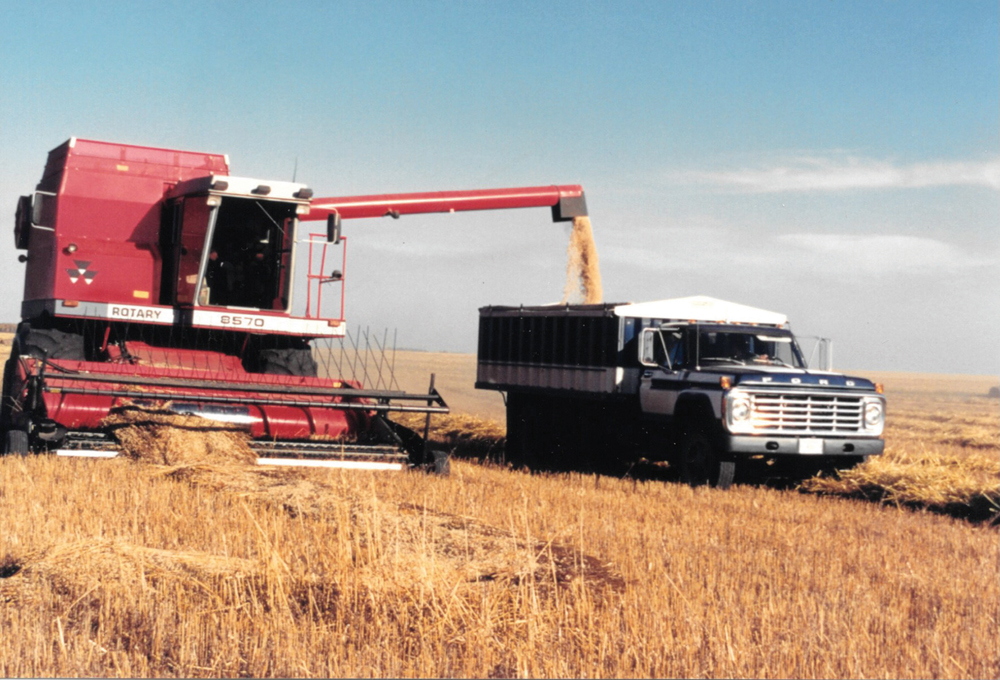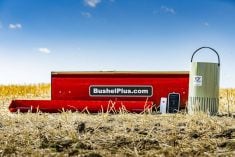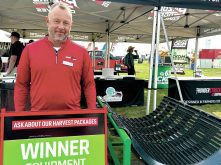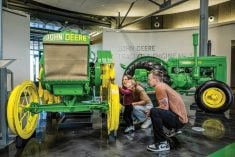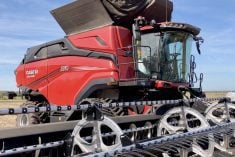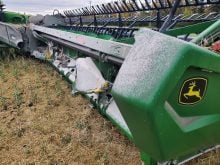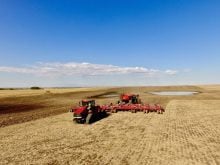This is Part 4 of a series about combines that occurs on no particular schedule. It seemed this was an appropriate time for something light and breezy. Part 2 (Grainews, September 26, 2017 issue) had a fair bit about Massey combines but this one is all about the red paint. I will take you back a bit to a combine few will know even existed.
The dry years of the 1930s ended with a 1939 wheat crop of 29 bushels per acre in the RM of Milden. In 1940, Grandfather Jerome Henry died, Les Henry was born, wheat prices were good and a good crop was on the way. The old wagon hitch combine was traded for a snappy Massey Harris No. 9 combine with a 12-foot cut and a tank.

The major event brought out the entire family for picture taking on or about the shiny new machine.
I remember riding in wagons to pick up grain from this combine. It did all the work until 1948 when green paint (Oliver 30) came along.
- Les Henry: Combines I have known, Part 3
- Les Henry: Combines I have known, Part 2
- Les Henry: Combines I have known, Part 1
Massey-Harris Super 27
My first experience with Massey was a MH Super 27. At age 14, I trucked the grain when brother-in-law Roy Gates used his MH 27 to combine a field of volunteer rye. The 27 was the big combine of the day but the big limitation was the electric table lift, which did not always work that well.
Read Also

Claas brings 1000 Series SP forage harvesters to Canada
In mid-August, Claas unveiled its new line of Jaguar forage harvesters at an event in Visalia, California, deep in the heart of that state’s dairy region.
Roy had been a dive bomber pilot in the Second World War and was a talented machine operator with little patience for stopping to dump.
He showed me the hand signals he would use to guide me so no grain ended up on the ground. His statement was, “If we could fly those airplanes wingtip to wingtip at 150 miles per hour, surely you can drive the truck at two miles per hour beside the combine.” That was the only thing I ever heard Roy say about the war.
For Remembrance Day 2020, his grandson James Gates wrote the song and performed the video “Keep it in the Sky.” Google jamesgates.ca/keep-it-in-the-sky-single to read the story, hear the song and see the video. Definitely worth four minutes of your time. Watching that was very emotional for me. Thanks, James. I have a copy of Roy’s logbook — he came back shot up sometimes, but managed to limp to home base.
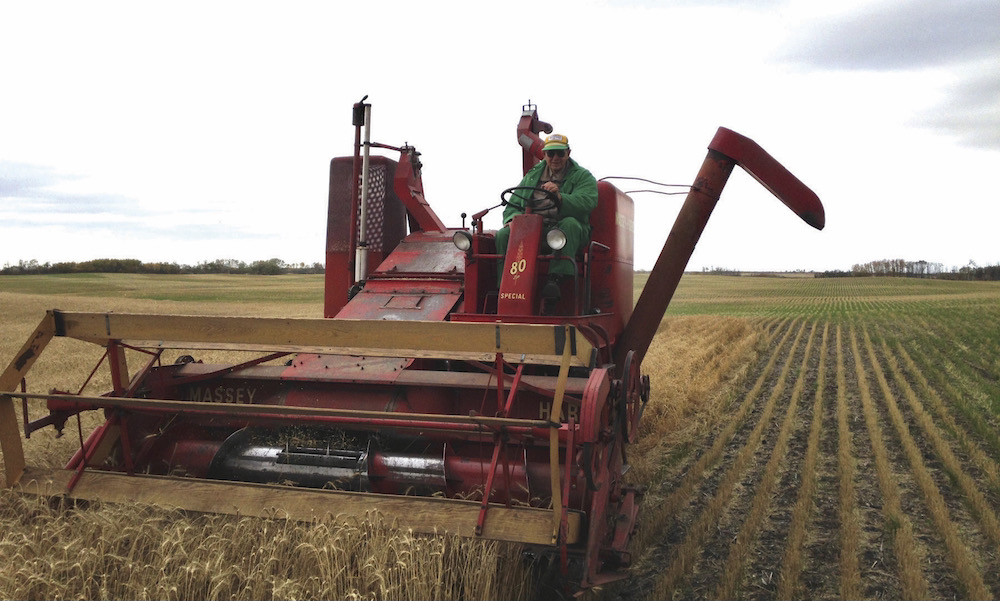
Back to Masseys. I spent a lot of time on 90 Masseys. The September 2017 column showed examples. The photo above shows a more recent experience.
A common problem with Massey — and all SP combines — was engine heating when the radiator screen plugged with chaff. The MH 82 and 92 had the big screen laid down beside the combine and a flap that went back and forth to allow chaff to drop, but it was not very effective.
The MF 410 and 510 were a big change with a factory cab and the unloading auger elevated to accommodate bigger trucks. The cab was nice on cold October days but on hot, August days it was a sweat box. The pull type of the day was the PTO-driven MF 405. I ran one for a day on the Roy Gates farm at Milden. One of the boys wrote “Howard the Turtle” in the dust on the grain tank. It was easy to plug it up if you got too rammy.
If the air conditioning quits, so do I
The first serious, comfortable Massey cabs were found on the MF 750 and 760 combines. They had serious capacity for the day and you sat in air-conditioned comfort. I spent many hours on a 750 at the Keith Ayres farm near Saskatoon. Keith was a colleague at the University of Saskatchewan soil survey and quit in the roaring ’70s to go farming near Saskatoon. After a few comfortable runs, I remember joking with Keith, “If the air conditioning quits — so do I.”
My next MF experience was at my son-in-law’s farm (Gerald Dauk) at Annaheim, Sask. That country is good, thick, black soil that grows good crops, especially with good management.
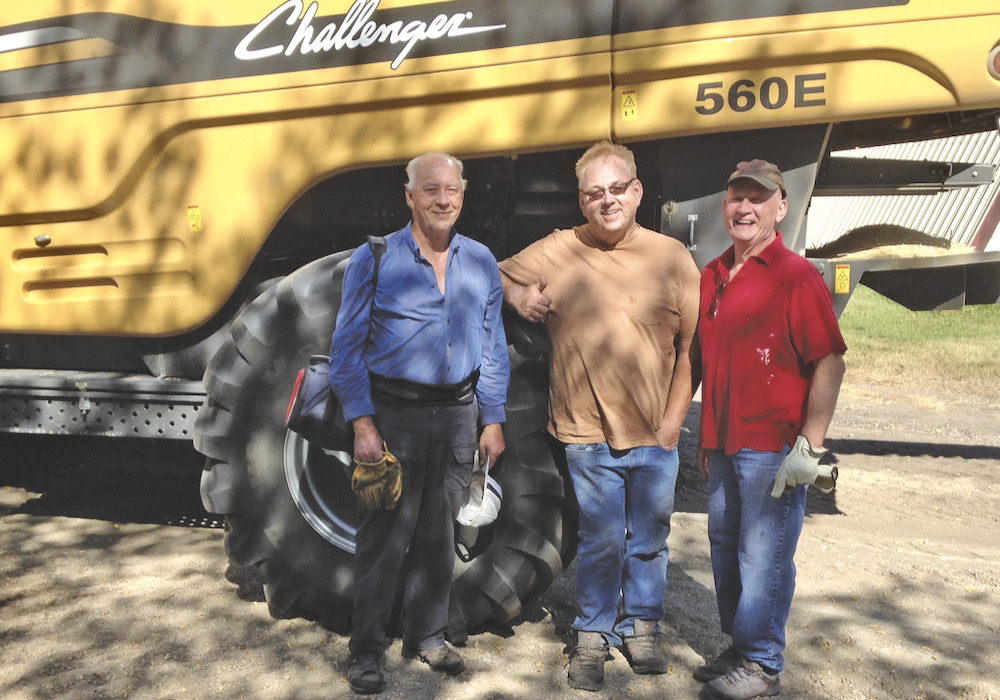
On a hot day with a big swath and lots of dust, the truck pulled up and we started to dump. I had not been watching the temperature gauge close enough. All of a sudden, bells went off, the radiator boiled and the engine shut down. Idiot proof — that was why the engine shut down. What does that say about the operator?
In a quarter section of 140 bushels per acre of oats with huge swaths, the 8570 would only do two miles per hour. The much bigger crops called for much bigger combine capacity. Then came the MF 9690 and MF 9895 — big threshing capacity. They had a bell that rang if it was pushed too hard and engine r.p.m. was an issue. But these were big capacity machines so that capacity should be used. My instructions were, “If the bell is not ringing at least once per round you are not pushing it hard enough!”
The last big shift I saw was to the MF 9560. My first instructions in operating it were to not be alarmed if I suddenly heard a huge noise that sounded like it was falling apart. Massey had finally solved the chaff collection problem on radiator screens. The fan was hydraulically driven and every so often it would stop, reverse the fan drive direction and blow off all of the chaff, so you started with a clean screen again. That innovation was actually patented so it could not be copied.
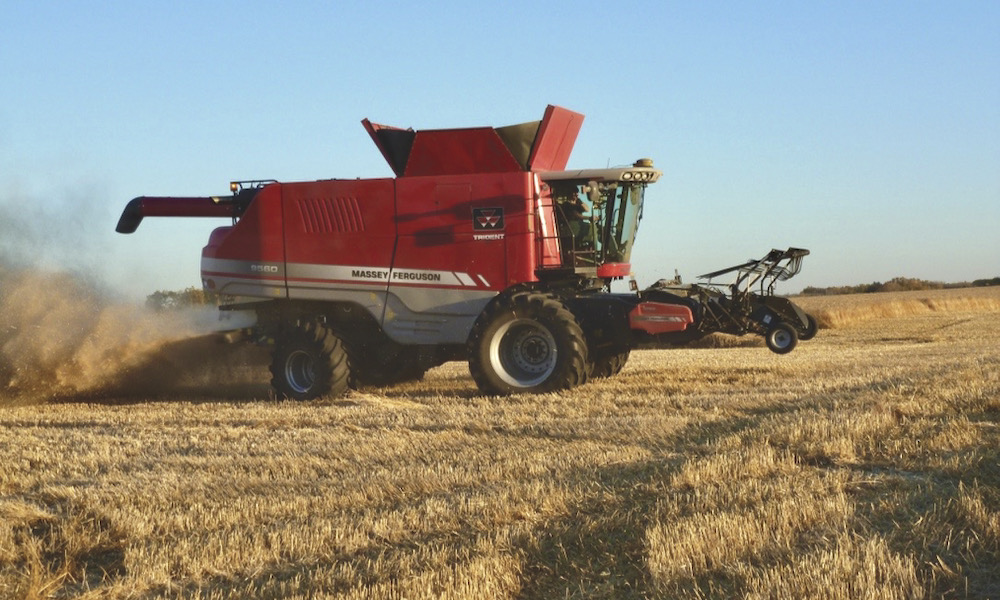
The later Massey combines also had a very good monitoring system. An outline of the entire machine was just above the windshield so you could see settings at a glance. The late Masseys also had a readout to tell you what bushels were in the tank. That was accurate and very useful information. Other makes did not do that — maybe they do now.
Big bucks left in the field
The 9560’s huge threshing capacity was great for cereals. But for canola, the separating capacity did not keep up to threshing capacity. That was especially true in dry conditions with a lot of fine stuff that prevented proper separation.
It was actually a peculiar circumstance that led to the finding big money was being left on the ground with big capacity combines in canola. Gerald’s brother, Murray Dauk, was just starting out combining, so he went very slow at first to get the hang of it. As time went on, he started to speed up. Lo and behold, every time he sped up, the yield monitor went down.
That led to a series of tests with weigh wagons, experts, etc., and the answer was clear. Slow down or leave big bucks in the field.
Long-time readers of this column will remember my report of several years ago. I was put on a flat piece of ground with huge canola swaths and told to go 1.6 m.p.h., and no faster. For a while, I thought I was back at Milden in 1955 with the old Oliver 30, where you had to put up a stick to be sure you were moving.
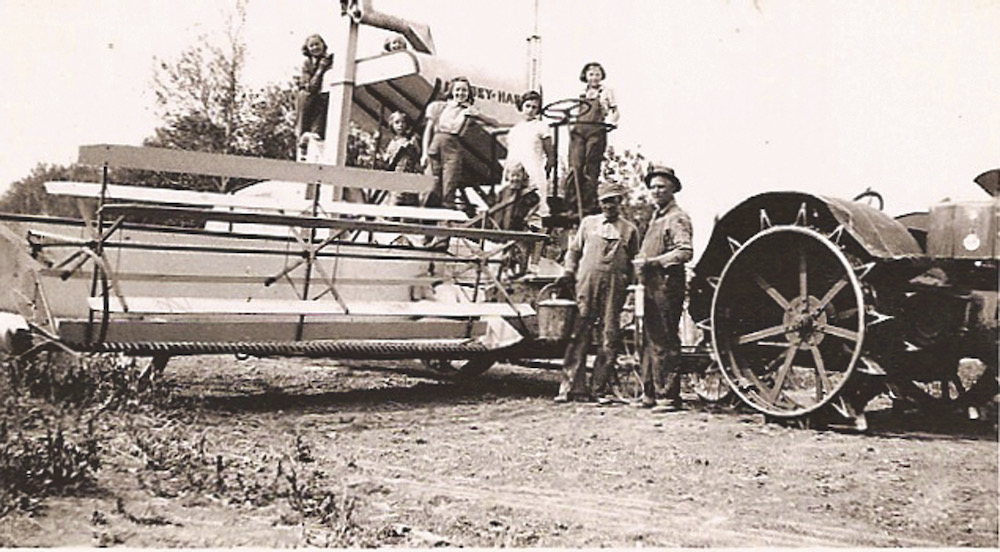
The yield monitor bounced around between 68 and 72 bushels per acre and the field average was about 70. Every time I goosed it up to capacity (approximately three m.p.h.) the monitor dropped to the mid-50s. Each swath was exactly one acre, so I did one swath at 1.6 m.p.h. and got 70 bushels in the tank. I went back on the next swath at near threshing capacity and put 55 bushels in the tank. Swathing was with GPS, so swaths were the same. I would not trust one rep so I did it again and got the same answer. That whole section was combined at 1.6 m.p.h. and 70 bushels per acre was the result.
For years we had gone along thinking 30 bushels per acre of canola was OK and 40 was great. So, if we are getting 55 what’s not to like? What’s not to like is the big bucks being left in the field. Can you imagine 15 bushels at $20 per bushel? This spring many are salivating over the possibility of $20 canola.
What’s next for Massey
An entire rethink has brought about the Ideal combine with black paint. I have checked them out at the Western Canadian Crop Production Show but not in the field. They maintained the Massey rad fan reverse system and have made the rotor much longer, so more separation occurs at the rotor. Time will tell if we finally have a canola combine with separation capacity matched to threshing capacity.


